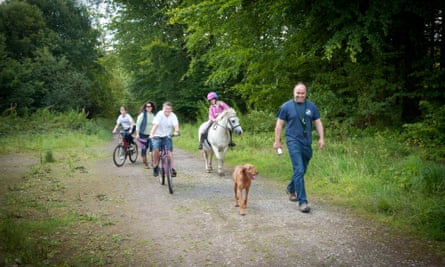
George Orwell’s “four legs good, two legs better” has long been the case when it comes to access to England’s forests, the British Horse Society contends. But “equality” may now be in sight. For decades, those wishing to ride horses on some of the country’s most beautiful off-road routes have had to seek a permit, a bit of paperwork that neither pedestrians or cyclists need.
Forestry England, which oversees that system, maintains that such paid-for permits are important in sensitive sites to avoid damage to the environment or clashes between horse riders and those enjoying a ramble or bike ride through the countryside.
The word in equestrian circles in recent days, however, is that despite some suspected reverse snobbery over the perceived high-born status of riders, the “discrimination” of the past may now be coming to an end.
A new consultation on the system of permits launched by the forestry agency in recent days and ending on 9 April has given some hope of a more equitable future to Mark Weston, director for access at the British Horse Society (BHS), and the 3 million riders he represents at the charity.
“Horse riders should have free access as walkers and cyclists have free access,” he said. “It is discrimination.
“In a lot of forests there aren’t permits at all, which just demonstrates to us that they are not really needed,” he added. “Forestry England’s justification is that the cost of the permits is reinvested into the routes but our view is that it doesn’t really happen and if it does happen, well, walkers and cyclists are benefiting from that investment at the cost of equestrians.”
The BHS argues that there is a strong safety argument for better access: in 2022 alone, 68 horses were killed on Britain’s roads and 139 people were injured.
Nevertheless, the way forward could be heavy going.
There have been well publicised clashes between cyclists and horse riders, most recently in the New Forest national park in Hampshire where a horse riding group called out a growing number of “rude and abusive cyclists”. It was noted that the growth of electric cycles meant users could cover large distances at a dangerously high speed.
But Weston said reports of such tensions were overblown.
“Sometimes it is said there will be conflict between horse riders, walkers and cyclists but everyone is allowed by law to use bridleways and the evidence is that such conflict does not exist,” he said. “There is a very, very small proportion – those stories make the news but it is normally on the road than elsewhere.”
To the argument that horses inflict greater damage to the bridleways, Weston responded: “I don’t think that is necessarily the case as the number we are talking about is so much lower in volume [than compared to walkers and cyclists].
“Also, what we are saying is that on a lot of routes in the forest you have 20-tonne logging machinery using those, so horse riders aren’t going to do any damage at all to surfaces. We have been lobbying for a number of years at the inequality and the inequitable existence of the permits.”
A leading cyclist charity has boosted morale at the BHS by also playing down concerns around overcrowding.
“Cycling UK believes these tracks should be open to cyclists and horse riders as a public right, rather than requiring permits,” said Sophie Gordon, Cycling UK’s off-road campaigns manager. “This has been the case for public forests in Wales and Scotland for almost 20 years without problems, and it would have great benefits in England for getting more people to be active outdoors.”
Weston said he expected there to be minimal resistance to the BHS’s case for jettisoning the permit system despite the sense among some in the equestrian community that they are seen as wealthy enough to pay their way.
“These days that is not the case and that is an old stereotype,” Weston said. “You only have to appreciate people out hacking locally on ponies aren’t from the wealthy sector of society. Old images are very hard to dissipate.”
Stuart Burgess, a spokesperson for Forestry England, said the consultation on how the permit system was working had received hundreds of submissions in just the few first days and that it would take six to eight weeks to assess the data.
He insisted that permits remained an important part of the management of England’s forests although there was no one clear expected outcome from the process. “We definitely need them in some particular places,” he said. “This is about whether they are working as well as can be.”



